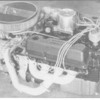I agree shorter is better, because you want the exaust gases to be as hot as possible to spin the turbine up quickly. The down side of course is the hotter the turbine side gets, the hotter the intake gets from conductive heat. I would think the absolute best place to mount turbos would be right beside the block just as close to the exaust valves as you could get it, tucked underneath the engine. That way you would only need a short lead for your oil lines too. You could draw the intake air through K&Ns from the bottom. That would be the coolest air you could get to. Then on the outlet you run it up alonside the engine to an intercooler that sits above the engine and to a plenum that sits just under the intercooler. From the plenum you could have short IR throttle bodies. this way you keep your plumbing to a minimum and that in turn keeps the weight down.
This was what I was thinking anyway. The downside is all that bling that you payed bick bucks for is mostly hidden from view.



